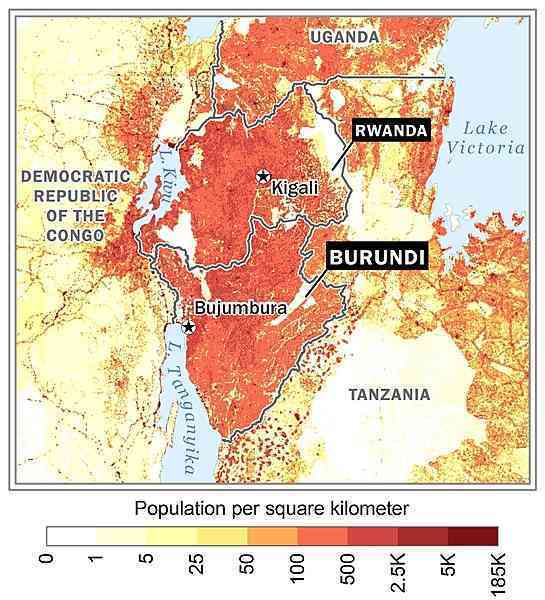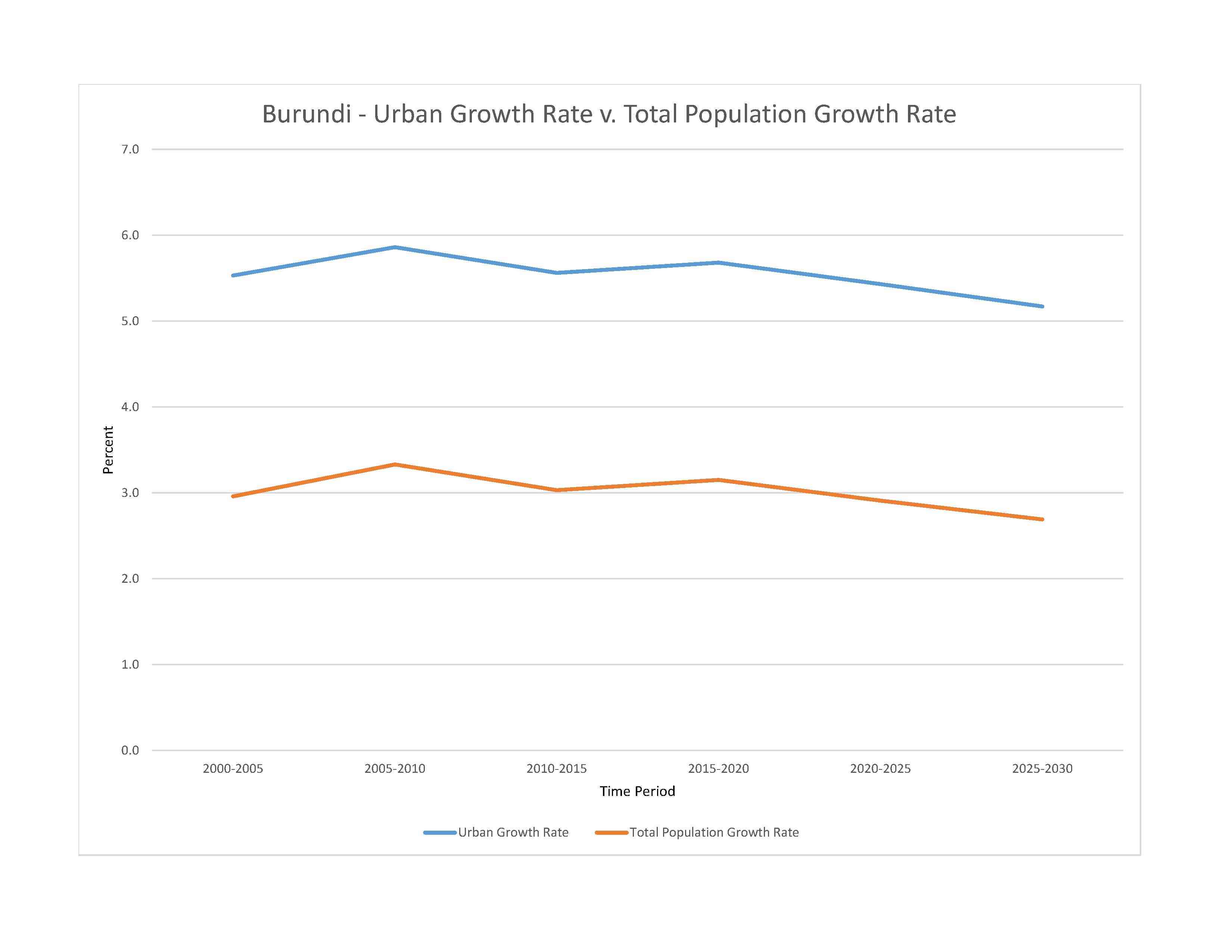
13,162,952 (2023 est.)
noun: Burundian(s)
adjective: Burundian
Hutu, Tutsi, Twa, South Asian
Kirundi (official), French (official), English (official, least spoken), Swahili (2008 est.)
major-language sample(s):
Igitabo Mpuzamakungu c'ibimenyetso bifatika, isoko ntabanduka ku nkuru z'urufatiro. (Kirundi)
The World Factbook, the indispensable source for basic information.
note: data represent languages read and written by people 10 years of age or older; spoken Kirundi is nearly universal
Christian 93.9% (Roman Catholic 58.6%, Protestant 35.3% [includes Adventist 2.7% and other Protestant religions 32.6%]), Muslim 3.4%, other 1.3%, none 1.3% (2016-17 est.)
Burundi is a densely populated country with a high population growth rate, factors that combined with land scarcity and poverty place a large share of its population at risk of food insecurity. About 90% of the population relies on subsistence agriculture. Subdivision of land to sons, and redistribution to returning refugees, results in smaller, overworked, and less-productive plots. Food shortages, poverty, and a lack of clean water contribute to a 60% chronic malnutrition rate among children. A lack of reproductive health services has prevented a significant reduction in Burundi’s maternal mortality and fertility rates, which are both among the world’s highest. With almost two-thirds of its population under the age of 25 and a birth rate of about 5 children per woman as of 2022, Burundi’s population will continue to expand rapidly for decades to come, putting additional strain on a poor country.
Historically, migration flows into and out of Burundi have consisted overwhelmingly of refugees from violent conflicts. In the last decade, more than a half million Burundian refugees returned home from neighboring countries, mainly Tanzania. Reintegrating the returnees has been problematic due to their prolonged time in exile, land scarcity, poor infrastructure, poverty, and unemployment. Repatriates and existing residents (including internally displaced persons) compete for limited land and other resources. To further complicate matters, international aid organizations reduced their assistance because they no longer classified Burundi as a post-conflict country. Conditions deteriorated when renewed violence erupted in April 2015, causing another outpouring of refugees. In addition to refugee out-migration, Burundi has hosted thousands of refugees from neighboring countries, mostly from the Democratic Republic of the Congo and lesser numbers from Rwanda.
0-14 years: 42.67% (male 2,830,996/female 2,786,154)
15-64 years: 54.03% (male 3,523,380/female 3,588,511)
65 years and over: 3.3% (2023 est.) (male 187,176/female 246,735)
total dependency ratio: 95.2
youth dependency ratio: 90.4
elderly dependency ratio: 4.8
potential support ratio: 20.7 (2021 est.)
total: 18.2 years (2023 est.)
male: 17.9 years
female: 18.5 years
3.59% (2023 est.)
34.9 births/1,000 population (2023 est.)
5.9 deaths/1,000 population (2023 est.)
6.8 migrant(s)/1,000 population (2023 est.)
one of Africa's most densely populated countries; concentrations tend to be in the north and along the northern shore of Lake Tanganyika in the west; most people live on farms near areas of fertile volcanic soil as shown in this 
urban population: 14.8% of total population (2023)
rate of urbanization: 5.43% annual rate of change (2020-25 est.)

1.207 million BUJUMBURA (capital) (2023)
at birth: 1.03 male(s)/female
0-14 years: 1.02 male(s)/female
15-64 years: 0.98 male(s)/female
65 years and over: 0.76 male(s)/female
total population: 0.99 male(s)/female (2023 est.)
21.5 years (2016/17 est.)
note: data represents median age at first birth among women 25-49
494 deaths/100,000 live births (2020 est.)
total: 36.8 deaths/1,000 live births (2023 est.)
male: 40.9 deaths/1,000 live births
female: 32.5 deaths/1,000 live births
total population: 67.8 years (2023 est.)
male: 65.7 years
female: 70 years
4.96 children born/woman (2023 est.)
2.45 (2023 est.)
28.5% (2016/17)
improved: urban: 98.7% of population
rural: 78.9% of population
total: 81.6% of population
unimproved: urban: 1.3% of population
rural: 21.1% of population
total: 18.4% of population (2020 est.)
6.5% of GDP (2020)
0.07 physicians/1,000 population (2020)
0.8 beds/1,000 population (2014)
improved: urban: 87.4% of population
rural: 53.7% of population
total: 58.4% of population
unimproved: urban: 12.6% of population
rural: 46.3% of population
total: 41.6% of population (2020 est.)
degree of risk: very high (2023)
food or waterborne diseases: bacterial and protozoal diarrhea, hepatitis A, and typhoid fever
vectorborne diseases: malaria and dengue fever
water contact diseases: schistosomiasis
animal contact diseases: rabies
note: on 31 August 2023, the US Centers for Disease Control and Prevention (CDC) issued a Travel Alert for polio in Africa; Burundi is currently considered a high risk to travelers for circulating vaccine-derived polioviruses (cVDPV); vaccine-derived poliovirus (VDPV) is a strain of the weakened poliovirus that was initially included in oral polio vaccine (OPV) and that has changed over time and behaves more like the wild or naturally occurring virus; this means it can be spread more easily to people who are unvaccinated against polio and who come in contact with the stool or respiratory secretions, such as from a sneeze, of an “infected” person who received oral polio vaccine; the CDC recommends that before any international travel, anyone unvaccinated, incompletely vaccinated, or with an unknown polio vaccination status should complete the routine polio vaccine series; before travel to any high-risk destination, the CDC recommends that adults who previously completed the full, routine polio vaccine series receive a single, lifetime booster dose of polio vaccine
5.4% (2016)
total: 4.07 liters of pure alcohol (2019 est.)
beer: 1.84 liters of pure alcohol (2019 est.)
wine: 0 liters of pure alcohol (2019 est.)
spirits: 0 liters of pure alcohol (2019 est.)
other alcohols: 2.23 liters of pure alcohol (2019 est.)
total: 11.8% (2020 est.)
male: 17.4% (2020 est.)
female: 6.1% (2020 est.)
27.6% (2022)
54.1% (2023 est.)
women married by age 15: 2.8%
women married by age 18: 19%
men married by age 18: 1.4% (2017 est.)
5% of GDP (2020 est.)
definition: age 15 and over can read and write
total population: 74.7%
male: 81.3%
female: 68.4% (2021)
total: 11 years
male: 11 years
female: 11 years (2018)
NOTE: The information regarding Burundi on this page is re-published from the 2024 World Fact Book of the United States Central Intelligence Agency and other sources. No claims are made regarding the accuracy of Burundi 2024 information contained here. All suggestions for corrections of any errors about Burundi 2024 should be addressed to the CIA or the source cited on each page.
This page was last modified 04 May 24, Copyright © 2024 ITA all rights reserved.